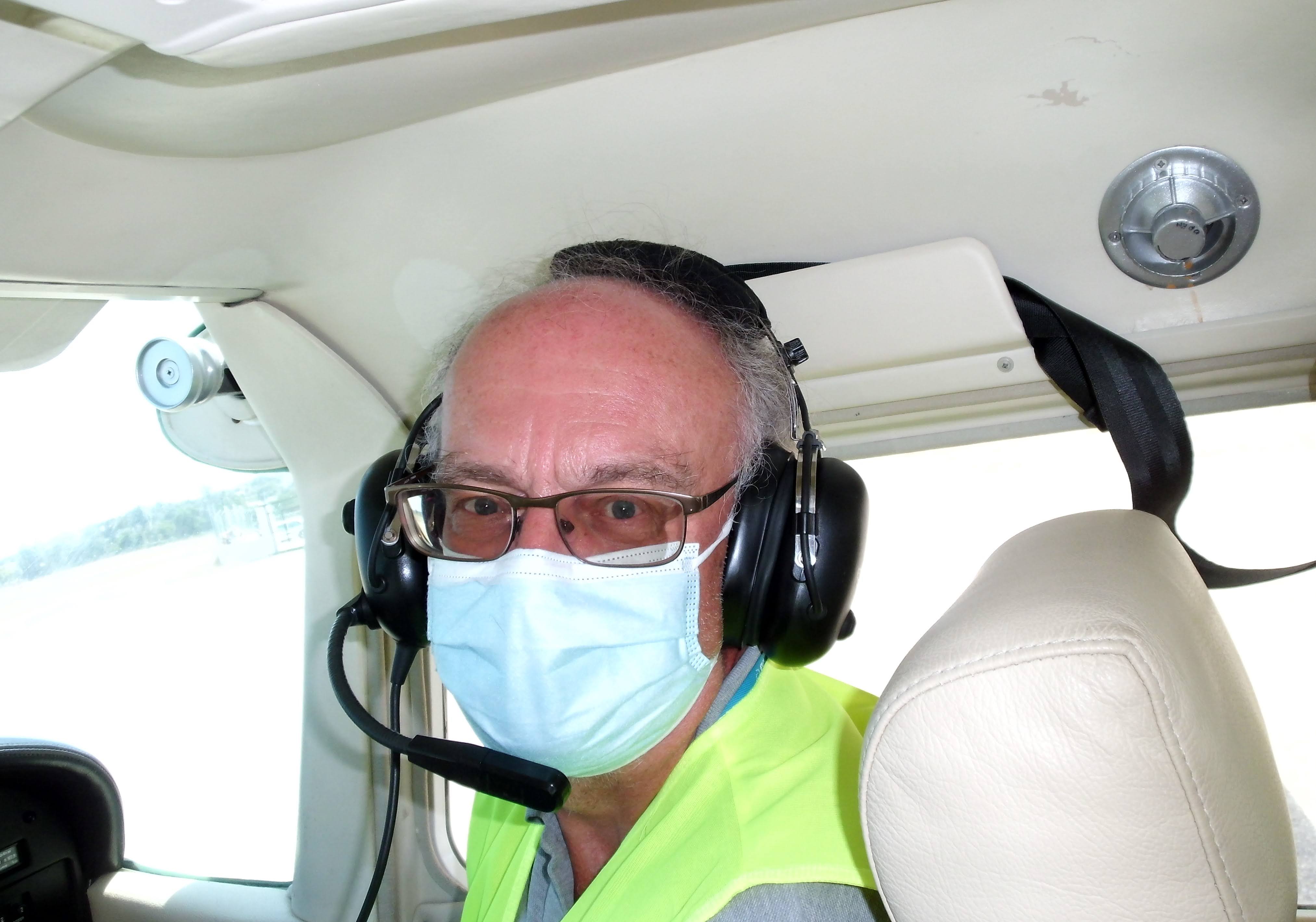Aviator
-
Cantrill, John Conway
Mr John Conway Cantrill
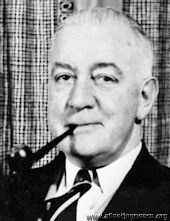 in 1961
in 1961'Jack', b. 28 May 1898 in Manchester.
Manchester University OTC then RFC (Admin Dept) during WWI, later test pilot for Avro. Volunteer instructor with the Lancashire Aero Club and, from 1930, Manager of Aviation Dept of Cellon [manufacturer of aircraft dope and finishes].
In 1925, "Mr. Cantrill, having no pupils down at the aerodrome, spent the afternoon shooting and returned with two good hares. This shooting is becoming a popular pastime for those who are waiting to fly."
Taught Winnie Brown to fly; rejoined the RAF in December 1939, again in the Administrative and Special Duties Branch.
In 1944 he resigned his commission as a Wing Commander, and rejoined Cellon.
d. 1978 on the Isle of Wight.
-
Carberry, Maia
Maia Carberry
wife of John (Lord) Carberry.
In September 1927 Alan Butler (with Peter Hoare as passenger), and Hubert Broad, who took Maia, went to Venice to support the British Team in the Schneider Cup in Venice.
In case you were wondering, "Mrs. Carberry wore a pale blue leather flying helmet to match the colour of her Moth aeroplane."
She owned:
a 1927 Fokker F.XI, G-EBUT VP-KAB/VH-UTO 'Miss Africa', and
a 1927 DH.60X Moth, G-EBSQ, in which she was killed in an accident in Nairobi on the 12 March 1928.
-
Carnegie, David Vaughn
Flt-Lt (later Sqn-Ldr) (Sir) David Vaughn Carnegie KBE CB AFC
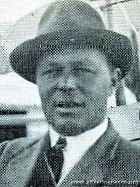
photo: 1930
One of the most experienced flying-boat pilots in the country: 3,000 hours by 1931.
RNAS during WWI, then flew in and around the Mediterranean and the Far East; spent 18 months as honorary instructor to the Singapore Flying Club.
Later an Air Vice Marshall.
-
Carr, Charles Roderick
Sir Charles Roderick Carr KBE CB DFC AFC
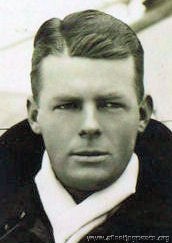
photo: 1916, when a Flight Sub-Lieut. in the Royal Navy, aged 25
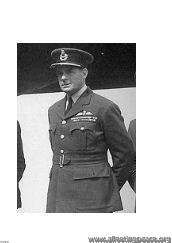
photo: 1947, aged 56
Born Feilding, New Zealand.
Part of Shackleton's last Antarctic expedition in 1921, later Air Marshall RAF and Chief of the Indian Air Force.
-
Carr, Reginald Hugh
Maj Reginald Hugh Carr DSM, AFC
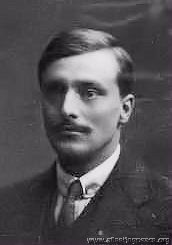
photo: 1913, aged 26
b. 9 September 1886 in Walthamstow, Essex, an 'Aeroplane Engineer'.
Won the the Michelin Cup in 1913 for the year's longest flight (315 miles), and competed in the 1914 Aerial Derby (coming 2nd); the 1914 London-Manchester Race (also 2nd), and the 1914 London-Paris Race.
19 Squadron in WWI, then a test pilot for Grahame-White.
d. 1968.
-
Carter, Larry L
Mr Larry L Carter
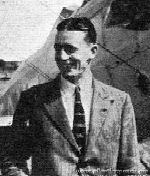 photo: 1923
photo: 1923One of the original AT&T pilots after WWI.
In May 1922, "Mr. Larry Carter had an unusual experience while flying the 10-seater Bristol from Paris to London on Wednesday. Just as he rose from the ground at Le Bourget one of the joints of his under-carriage became loose, and a portion of the under-carriage was left hanging down. This was quite unnoticed by Mr. Carter, but the officials at Le Bourget saw what had happened and wirelessed to Croydon a full description of the occurrence. The wireless operators at Croydon, as soon as Mr. Carter came within speaking range, "rang him up" and told him what had happened. Mr. Carter, being thus warned of what difficulties were in store for him when the time came for him to land, was able so to manoeuvre his machine that, after a landing which excited the admiration of all the pilots on the aerodrome, only the tip of one wing was damaged. Had he not been made aware of the breakage in the under-carriage it is highly probable that a serious crash would have resulted."
Gloster's test pilot from 1923; he flew the prototype of the Grebe (derived from the SE5) in that year's King's Cup race.
Fractured his skull and broke a leg when the Gloster II racer crashed in 1925, and in 1928 (not having flown since) died from meningitus, aged 28.
-
Caspareuthus, Rhinhold Ferdinand
Capt Rhinhold Ferdinand Caspareuthus 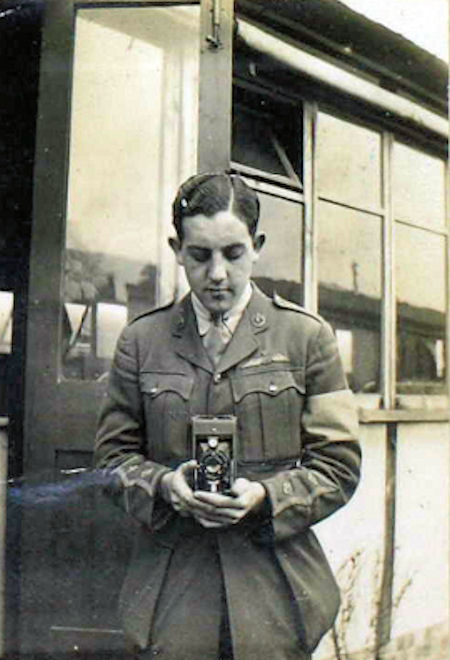
b. Paarl, S Sfrica, 9 Sep 1899
Ikmperial Airways, based in Cape Town from 1929
Promoted to Senior Master in October 1938
-
Cathcart Jones, Owen
Lt Owen Cathcart Jones
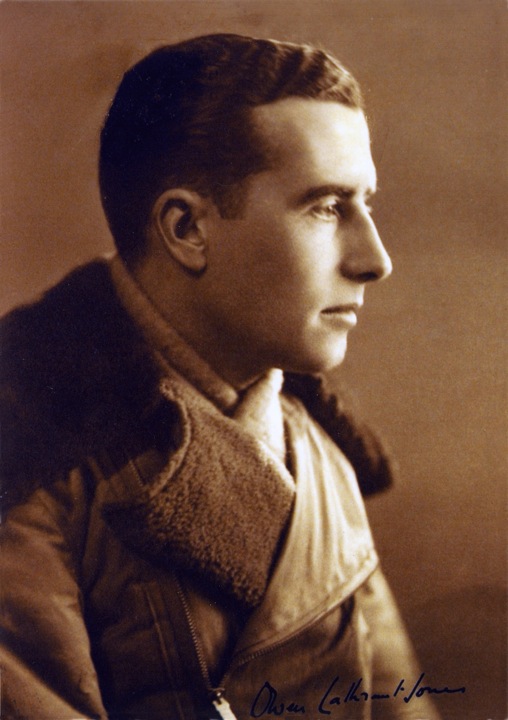
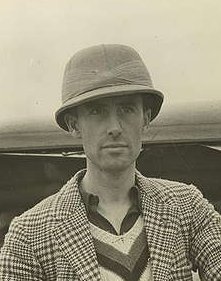 1934
1934 Born 5th June, 1900, London (definitely not Canadian, despite some nasty rumours).
McRobertson Centenary Gold Medal 1934
Royal Aero Club Silver Medal 1934
Holder of 8 Long Distance World Records. 1934
It's difficult to know what to make of Owen Cathcart-Jones, really; he was handsome, adventurous, undoubtedly talented, and clearly an excellent aviator - but, I'm afraid, rather prone to go 'AWOL' - both in his personal and service life!Born in London on 5 June 1900, he joined the Royal Marines in 1919, then, after the usual period of general service he volunteered for flying and joined R.A.F Netheravon on 12 January 1925, in the first batch of Marines officers to be transferred.
He was awarded his 'wings' in August 1925 and was posted to RAF Leuchars, serving with 403 Flight on HMS Hermes, and 404 Flight on HMS Courageous, taking a hand in the troubles in China in 1926-27 and again in Palestine in the following year.
In 1927, he wrote to The Times:
Sir,
On July 17 I had occasion to be flying down the east coast of Greece, and when in the vicinity of Mount Kissavos, near Larisa, I was astonished to see a large golden eagle fly past my aeroplane on a parallel course at a distance of about 80 feet away. The bird did not appear to be at all concerned at the noise of the engine, and in fact turned its head round to look at the aJrcraft on passing. The speed on my indicator showed 70 knots, and the height by my altimeter was 4,000 feet. Judglng by the speed at which I was passed by this bird, I should estimate that it must have been travelling at 90 mp.h.; which I consider to be quite a phenomenal speed for such a large bird at that high altitude.
Yours faithfully,
OWEN CATHCART-JONES,
Lieut. H.M.S. Courageous, at Skiathos, Greece, July 22.
which prompted Mr Seton Gordon, from the Isle of Skye, to reply:
Sir,
The letter from Lieutenant Owen Cathcart-Jones in The Times of July 27 which describes the great speed of a golden eagle in flight is of interest to me, as I have for some time believed the eagle to be one of the fastest birds. On one occasion I satisfied myself that an eagle was travelling at a good 120 miles an hour - probably much more -but then the bird was rushing earthward from a considerable height, and Lieutenant Owen Cathcart-Jones's bird was apparently on a level course. Little is definitely known even to-day as to the maximum speed any bird is capable of. Not so long ago a senior officer of H.M.S. Hood told us that when the Hood was steaming 34 miles an hour into a 15-mile-an-hour wind a formation of guillemots had no difficulty in forging ahead and crossing the vessel's bows. This interesting record shows that even the humble guillemot is capable of an air speed of well over 50 miles an hour, so a speed of 90 m.p.h. is not surprising in a bird of the wing power of a golden eagle.
I am, &c.,
During this time, he met Audrey, the wife of Captain Hugh Fitzherbert Bloxham, late of the Indian Army, then a Colonial Office official in the Prison Department at Hong Kong. Hugh and Audrey had married in St John's Cathedral, Hong Kong, on 6 August 1925.
Clearly Owen and Audrey got along rather well, and in November, 1927, their daughter Imogen was born.
Hugh duly sued Audrey for divorce in May 1928, "on the ground of her adultery, at the Hotel Savoy, Hong Kong, with Lieutenant Owen Cathcart-Jones, of the Royal Marines." The petition was uncontested.
On 12 Aug 1929 in Malta, Audrey had a son, Anthony.
"He established a reputation as a forceful and daring pilot, and one of his escapades became the talk of the Fleet; on 22 Aug 1929 he was on exercises with the Fleet and loaded his plane with a large packet of "service brown" toilet paper intending to drop it on H.M.S. Revenge which should have been last in the line. Unfortunately the C-in-C had inverted the line and he dropped the "bumph" very accurately on the Flagship, H.M.S. Queen Elizabeth. His Flycatcher aircraft was clearly numbered "7" and the Captain of H.M.S. Courageous was called to the Flagship on return to harbour to explain. Cathcart-Jones duly appeared before the Admiral with his reasons in writing [he made up some nonsense about it acting as a 'sighter' for actual bombs] and had to be on his best behaviour for some time."
On 26 November 1929 he made the first ever night deck landing in a fighter aircraft, flying a Fairey Flycatcher from H.M.S Courageous.
"It is a reminder of our one time presence in the Middle East that his record shows his Flight carrying out patrols in Palestine, and the Courageous Flights being shore based at Gaza and Aboukir in 1929 during the 'Civil War'.
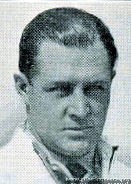
During his Fleet Air Arm service he became very friendly with a wealthy Naval Officer, Glen Kidston, with a similar passion for flying. Kidston was himself leaving the Navy and Cathcart-Jones decided that it was time to do likewise and to transfer his interests entirely to civil flying. He went on to half pay on 17 Febuary 1930 [for 6 months], joined National Flying Services Ltd. and never returned to the Service.
Audrey, by then aged 28, with Imogen (aged 2) and Anthony (aged 1) sailed from Brisbane to Plymouth on the P&O steamship Ballarat, arriving there on 21 Jan 1930.
On 21 April 1930, National Flying Services held their first display at Hanworth Park; Owen provided the finale by bombing a level crossing to bits. However, the meeting was not a success; "for some reason N.F.S. shows do not appeal to the average private owner" and crowds were poor.
In September 1931 he flew a D.H. Puss Moth, with Audrey as passenger, in the Deauville-Cannes Air Rally. After lunch and a gala dinner, they flew on to Cannes, despite a forced landing in the Alps when the fuel pipe and filter were found to be blocked with sand.
By the following May (1932), business was better; "taxi work is now on the increase and the N.F.S. pilots have been kept busy flying to places as widely separated as Plymouth and Berlin". Owen piloted G-ABTZ, a Stinson Junior belonging to Mr. E James, on several flights. On 31 July 1932, Audrey went on a conducted tour organised by NFS, of "eight Moths, one Bluebird and one Alfa Romeo", to Ostend.
Owen and Audrey lived in Tudor Court, Hanworth, London until 1934, but then Owen moved out, leaving her and the two children, who relocated to Wavenden, Bucks. In company with Kidston he broke 8 World records for long distance flights in 1934, including England to South Africa in a Lockheed Vega:
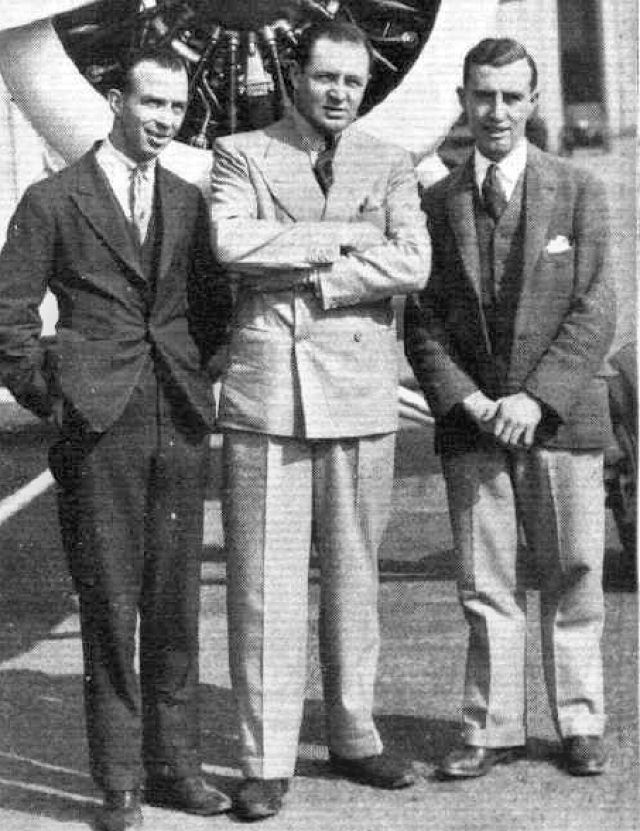
but Glen (centre) was killed in an air crash shortly afterwards.
Owen also came 6th in the 2nd Morning Post Cross-country Air Race on 6 June 1933, and competed in the King's Cup in 1934 (finishing 9th) and 1935 (when he came a creditable 3rd).
Here he is, wandering around waiting to take-off, and taking a pylon in the final of the King's Cup 1934:
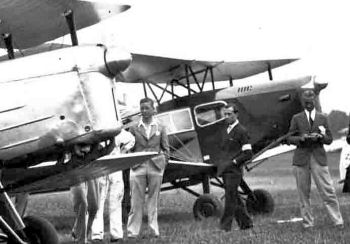
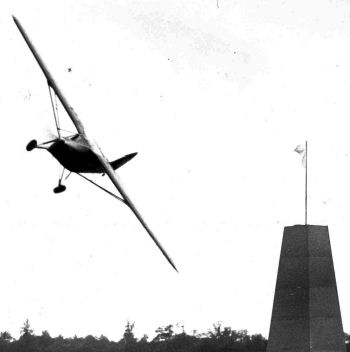
His real moment of glory was to co-pilot with Ken Waller the specially built D.H. Comet in the 1934 McRobertson England to Australia Centenary air race, in which they were awarded third prize in the Speed Handicap. On arrival they immediately turned round and flew back to England and established a record for the round trip.
Originally, he had teamed up with Miss Marsinah Neison in a Lockheed Altair (or Vega), "placed at their disposal by the builders", or possibly a Northrop Delta. However, nothing came of this.
He certainly wasn't first choice as Comet pilot - Bernard Rubin, the owner and intended pilot of the aeroplane, fell ill and originally nominated as substitute Mr Smirnoff 'the well-known Dutch pilot' on October 1st, and then only on October 5th (2 weeks before the race) 'finally and irrevocably' decided it should be Owen who accompanied Ken Waller. Three weeks before the Race, Owen had "never heard of Mr Rubin or Mr Waller", but apparently Marsinah said "Seajay, why don't you try and take Rubin's place?" Owen considered this a "most sporting action" on her part, but this meant that he had very little time to familiarise himself with the notoriously-tricky aeroplane.
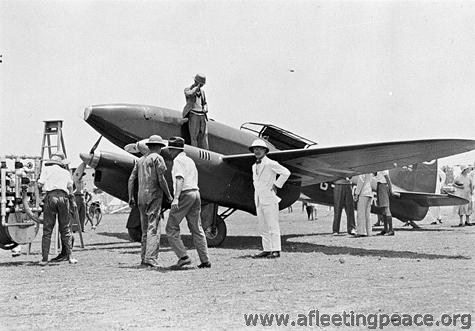
After the return trip from Australia, Owen said "We have averaged 10 hours' flying every day, and covered approximately 2,200 miles a day. We wanted to make this flight back not so much as a speed flight, but as a flight which could be copied for commercial purposes. We have flown only by day, and have had time to sleep, eat, and wash. From the commercial point of view I think there is no reason why there should not be a service between Melbourne and England on similar times to those we have taken, certainly for the carrying of mails.
People in the Colonies were very anxious to have their letters quickly and to have air-mail services covering the distance in so short a time. We had one nasty moment at Allahabad, when we had trouble with two of the cylinders, but the Mollisons came to the rescue and lent us spare parts - a very sporting action. We were greatly disappointed by the delay at Athens owing to bad weather conditions, which prevented us from getting to Lympne yesterday."
Messages of congratulations included this one: "The Duke of Gloucester directs me to congratulate you both on a magnificent double flight - Private Secretary, Duke of Gloucester.
However, even while he was away, the law was after him: "ENGLAND-AUSTRALIA AIR PILOT SUMMONED. Flight Lieutenant Owen Cathcart Jones, of the Naval and Military Club, Piccadilly. who is taking part in the air race to Australia, was summoned at Bow Street Court yesterday, on a charge of using a motor-car with an expired Road Fund licence. He did not appear, and on being informed that Lieutenant Jones was one of the competitors in the England-Australia race, Mr Dummett adjourned the summons sine die."
In 4 April 1935, several visitors arrived by air for the Norfolk and Norwich Annual Dinner, including " Lt. O. Cathcart-Jones and Miss M. Neison in a Puss Moth".
He published his "Aviation Memoirs" in 1935; "... breezy, light and interesting... the book is unusually well illustrated, with photographs which Mr. Cathcart Jones has collected or taken himself, and many of these photographs are extremely graphic and educative." Interestingly, Owen rather neglects to mention anything about his wife and children.
In 1935, Ken Waller got annoyed with him for something he said in this book that Ken felt "reflected on his courage and ability as a pilot", and even went to court over it. Owen replied that "that was the last thing he intended, as Mr. Waller and he had been, and still were, very good friends", which seemed to settle the matter.
Reading the memoirs, I can only assume this was the passage where, having got themselves lost in bad visibility over Arabia during the Race, Owen says that "little did I know that Ken was on the point of asking me to dive the machine into the ground and get it all over rather than face the possibility of running out of petrol, forced landing in the sand, where we certainly would have smashed the machine, and then lie there slowly dying without means of help."
In fact, Owen's is a rather bland account of their two-way trip, and at one point Owen credits Ken with a 'marvellous achievement'; "Ken, under great difficulties, made a superb landing".
Also in 1935, he drove a 4.5 litre Lagonda Rapide in the Monte Carlo Motor Rally, starting from Stavanger in Norway. He was the first competitor to arrive in Monte Carlo, and was thought to have a good chance of winning the first prize, but was eventually placed 34th. His 'second-in-command' was a Miss Marsinah Neison, "one of the very few women to hold a 'B' licence for aircraft".
Owen and Marsinah got up to quite a few things together:
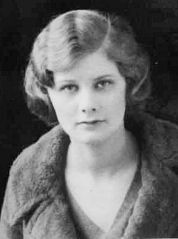
Beatrice Marsinah Neison, b. 3 Dec 1912 in Reigate. She gained her RAeC certificate at National Flying Services, Hanworth on the 11 Jan 1932, and passed the night-flying test in September.
Owen says of her "a young commercial pilot came to me for some advanced flying instructions, and I was very much impressed with the exceptional ability shown by her. Miss Marsinah Neison was the youngest girl pilot to get the coveted 'B' commercial pilot's licence. She qualified for it at the age of nineteen." He reckoned "there was very little I could teach her... I decided that her abilities were far too high to waste, and asked her to join me in any free-lance air charter work in which we could combine".
I'm not suggesting anything untoward, you understand...
In November 1933, she was trying to raise finance for a solo flight to Australia in a Comper Mouse, to beat the record held at the time by CTP Ulm, but never did.
Here she is, ready to go:
She sailed to California in May 1936, to visit her friend 'Russell Pratt', (sounds like an assumed name to me...) and to New York in July 1937. She married Hart Lyman Stebbins of New York 'very quietly' in London in December 1937, (they appear in the 'New York Social Register', whatever that means, for 1941), then Angus MacKinnon in July 1947. She died 29 April 1997 in Hampshire (England).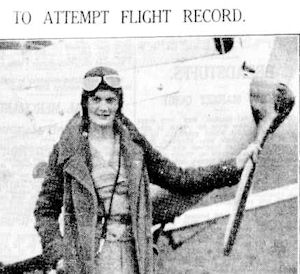
Anyway, Owen was by now pretty well-known; in May 1935, for example, he, Mrs Mollison (Amy Johnson), Tom Campbell Black, and other aviators took part in a 'Mock Trial', in aid of King Edward's Hospital Fund for London, at the London School of Economics; they were charged with 'Making the world too small'. The following August, he was chief pilot in the 'Jubilee Air Display', also with Tom Campbell Black.
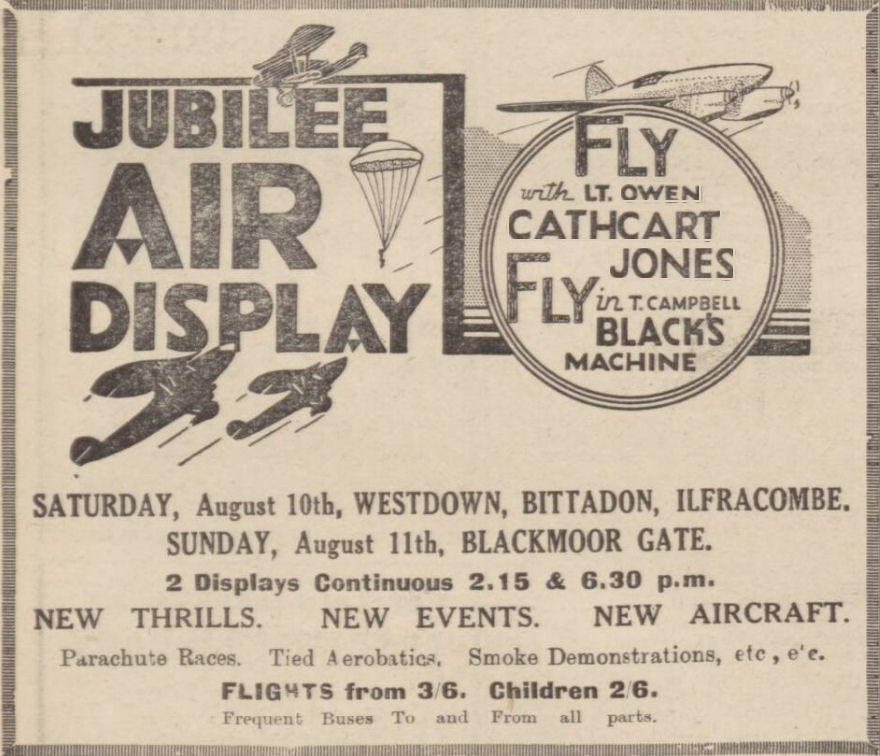
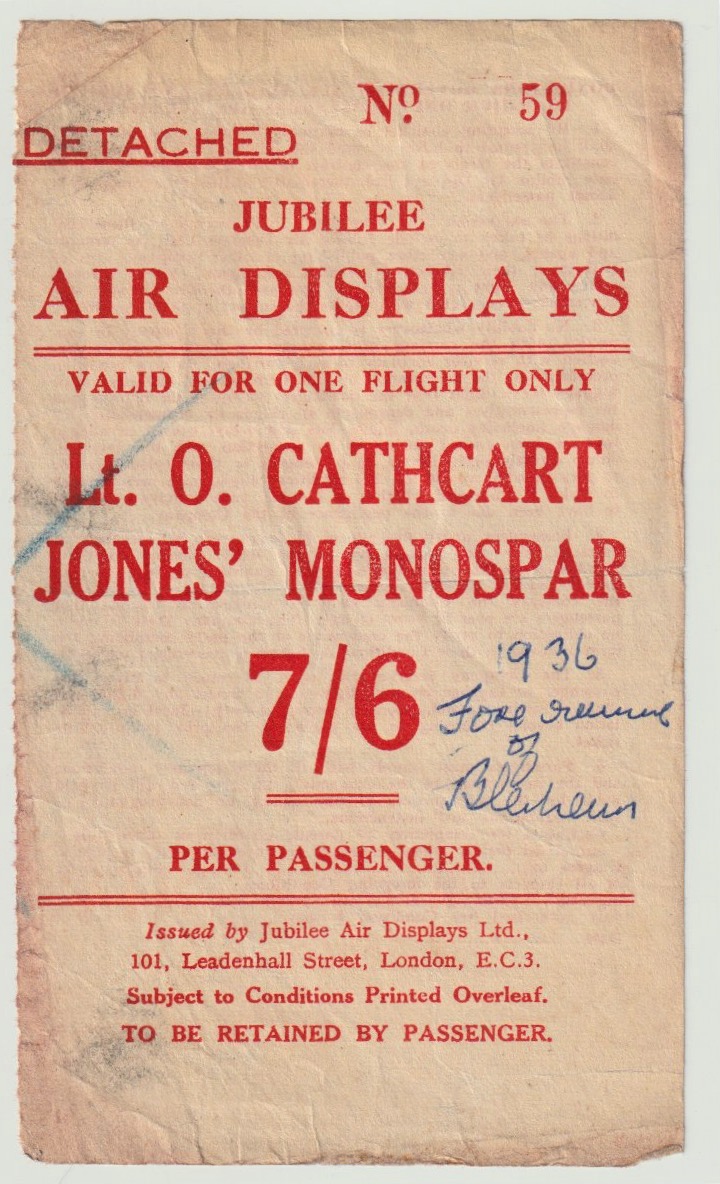 via Joss Mullinger
via Joss Mullinger"Lieut. Owen Cathcart-Jones and Mr. T. Campbell Black, two of the keenest rival prize-winning pilots in the great England-Australia Air Race last year, are combining in a brilliant partnership to take a leading part in the Jubilee Air Display which will be given at Home Farm, Tehidy, Camborne, Thursday, August 15th. 2.15 till dark. The display which is visiting no fewer than 180 centres throughout Great Britain during the summer months, has been specially planned to provide a striking demonstration of the supremacy of British modern commercial aircraft and the unrivalled skill of British pilots. Public interest in aviation has never been more keen than it is at the present moment."
Don't be fooled into thinking you might have flown in the D.H. Comet, though - Owen flew passengers in a four-seat G.A.L. Monospar, and Tom took them up in an Avro Cadet, a rather pedestrian trainer.
On 31 July 1935, Owen advertised, again in The Times: "Mr Owen Cathcart-Jones requires sponsor to finance building world's fastest commercial aeroplane for nine special long-distance record flights in 1936-7 showing profitable return."
Nothing came of this either...
By December that year, however, Owen was banned from flying in Argentina because of his 'stunts'near a military aerodrome; the following April, his aeroplane was impounded by the Austrian authorities and he had to make his own way back home via Cannes.
Gigi Jakobs tells me that "I came across his name in divorce proceedings for Robin W.G. Stephens and Phyllis Gwendlen (nee Townshend) Fletcher. They started divorce proceedings in late 1936 because, according to Stephens, his wife had committed adultery with Cathcart Jones from Dec 1935 to May 1936."
26 Jan 1937
"Owen Cathcart Jones, the well-known airman, of Grosvenor Street, London, failed to appear at his first meeting of creditors at the London Bankruptcy Court to-day. The assistant official receiver stated fhat the debtor had failed to surrender under the proceedings. A distress was levied at his flat last December, and goods sold in January. A representative of the petitioning creditor said that the debtor took an aeroplane to South America for demonstration purposes. The debtor sold the machine and failed to account for the proceedings, and a judgment for £660 had been obtained against him. Mr Newman said that the debtor in August last was alleged to have landed in Czechoslovakia with two Spanish Nationals, and subsequently disappeared. Whether he is in Spain or not I don't know." said Newman, "but I believe he was in this country December 22 last." The case was left the hands of the Official Receiver as trustee."
The bankrupcy hearing was first delayed, then postponed indefinitely; Owen didn't turn up for any of the meetings.
He somehow became an instructor at the London Air Park Flying Club at Hanworth, an elite government-subsidized club for wealthy patrons. His fellow-instructors included David Llewellyn and Ken Waller.
Five years later, he was, somehow, a Squadron Leader in the Royal Canadian Air Force:
"In March of 1942 he was posted to Western Air Command Headquarters, but nothing is recorded in the WAC HQ diary to confirm this or indicate duties. He was then ‘Posted to ABS’ (Absent), 29 April 1942. It appears that he had gone AWOL (Absent Without Leave), as the diary of Headquarters, Western Air Command, under date of 6 July 1942, read in part, ‘Squadron Leader O.Cathcart-Jones who has been AWL for some time, returned from California to this Headquarters under escort.’ He is then shown as taken on strength of Western Air Command Headquarters, 6 July 1942. Two months later, he was ‘Retired’ from the RCAF”.
Hugh Halliday fills in some background:
"He was living in Mexico City in April 1940 when he applied to the RCAF and was duly commissioned in that force on 16 May 1940 (Pilot Officer, simultaneous promotion to Flight Lieutenant). He was assigned to the Air Member for Operations and Training, AFHQ, and performed well enough that he was promoted to Squadron Leader, 1 June 1941. The timing of this suggests (but I cannot prove it) that he was advanced in rank to give him more credibility with American authorities.
In April 1941 he was sent to California on temporary duty as Special Advisor to Warner Brothers for the film “Captains of the Clouds”. The RCAF paid him a special allowance of $ 10.00 a day for the time he was there. He seems to have considered California a bit of a “hardship posting” because of high costs and a depreciated Canadian dollar. He nevertheless wrote to people at AFHQ (Ottawa) on Warner Brothers stationery, at one point urging that he not be forgotten when operational postings were distributed. As of 20 February 1942, Hal Wallis (Director of the film) was effusive in his praise of Cathcart-Jones both in production and publicity preparation. His services with Warner Brothers apparently ended that day.
On 4 March 1942 he reported back to the RCAF on posting to Western Air Command Headquarters (Victoria, British Columbia). About a month later he was advised that he was to be posted to Station Alliford Bay as Operations Officer. A remote station in the Queen Charlotte Islands, it might nevertheless have been deemed to be in a zone of potential intense operations, given the panic that had engulfed the West Coast following the opening of the Pacific War. Cathcart-Jones would have nothing to do with it. He pleaded personal difficulties – privately he stated that he regarded Alliford Bay as a backwater – and he argued for assignment to Seattle as a Liaison Officer. On 27 April 1942, Group Captain A.D. Hull (WAC Headquarters), having interviewed Cathcart-Jones, wrote, “Squadron Leader Cathcart-Jones has undoubtedly ability. However, he appears to put his personal affairs before the Service. Should be closely supervised on new posting and given an opportunity to prove his initiative and worth.”
The same day (27 April 1942) he was issued a travel warrant to travel from Victoria to Vancouver and thence to Alliford Bay. By then he had cleared out his Victoria apartment and disposed of his books. He took the boat to Vancouver. On 28 April 1942 he crossed the border into the United States, in uniform, stating that he was on RCAF duty to the Fourth Interception Command, and that he was waiting for orders from Ottawa. He then hastened on to Hollywood.
On 29 April 1942 he wrote to Western Air Command Headquarters, submitting a resignation from the RCAF. Since he was already a deserter, the “resignation” was not accepted. In June 1942 he was arrested by American authorities, charged with having made false and misleading statements on entering the United States. He sent a message to WAC, asking that confirmation be sent that he was in California on RCAF Liaison Duty. This, of course, could not be provided (one is struck by the man’s sheer cheek). He was returned under arrest to Canada, reporting back to WAC Headquarters, and his case reviewed in detail on the 9th. Among the issues disputed were his debts ($ 884.09) and whether he should be “retired” or be allowed to resign his commission (his preference). He was retired. It was deemed that a General Court Martial for an AWOL case was “over the top” – he just was not worth it. He had not been paid since the day he went AWOL."
During his time with the RCAF he designed a board game, for which he did all the artwork; he was then involved in The Movies (Technical Director, and a 30-second appearance as 'Chief Flying Instructor' in 'Captain of the Clouds', of which Flight said " it is a first-class production in almost every respect" ).
See the excellent article on Vintage Wings of Canada's website.
He then got mixed up in some tawdry goings-on with Errol Flynn and a Miss Peggy Satterlee..
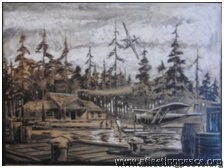
"This painting was done by Squadron Leader Owen Cathcart- Jones when he was an advisor on the movie 'Captains of the Clouds'. He also played a part in the movie. The painting shows the Hudsons Bay Co. trading post where the movie was filmed. When my father-in-law was ten years old, Cathcart-Jones gave him this lovely painting."
with thanks to http://relicsandtales.blogspot.com
He eventually bought a ranch to raise polo ponies, and became President of the Polo Club in Santa Barbara.
His daughter Imogen married John Otis Thayer (from Boston, Massachusetts) in September 1947. She was described as 'the daughter of Mrs A Cathcart-Jones of Wavedon, Bletchley, Buckinghamshire'.
Audrey died in 1962; her son Anthony in 2005.
In 1981, he wrote to 'Flight' "I had a bad accident at polo when I was knocked from my horse and fell on my head, but I am now almost completely recovered and back playing polo again."
Owen died February 1986, in California, aged 85.
Postscript
Imogen's son David actually met him: "Owen lived at 305 San Ysidro Rd., in Montecito. His ranch was about 4 acres at the end of a long driveway that passed through avocado orchards owned by the people who lived down on the road. It's been sub-divided and developed.
Some years ago, I walked up the driveway to discover that his house had been replaced by a large, pink, stucco hacienda and there's a second house, next-door, where his riding ring was. The avocado orchards down by San Ysidro Rd., are gone, too.Owen's sixth wife, and widow sold the place and moved to La Jolla a couple of years after he died. She died three or four years ago.
Imogen was reconnected with her father in the early 50s - he came to visit in 1952 and they wrote and phoned, after that.In the summer of 1965, my parents and their five kids drove out to Montecito, in a camper, and spent about a week at Owen's, just before he married his sixth ? wife, Pat, in August 1965.The following summer, 1966, I went out to visit him for two weeks, and was stranded in Montecito, for the whole summer, because of an airline mechanics strike which grounded the major airlines for 50+ days!It was great fun. My grandfather had to put me on the Continental Trailways bus, in September, to get me back to New York, in time for the first day of school.Owen had a second son, Colin, with his wife, Elizabeth Toomey, who he wooed away from her husband, in Buenos Aires, in 1936. She was married to a Mr. Waterman, who was, according to my grandfather's widow, Pat, the heir to the Waterman ink company. They married and had a son, in England, and came to NY soon after the boy was born. Evidently, in NY, he got involved with Marsinah Niesen, who was there and married to a Mr. Stebbins, and my grandfather walked out on Bette, leaving poor Bette to raise Colin in Queens, NY, with the help of her parents! She got no support from Owen.We have a January 1939 letter, from Colin's mother to my grandmother, Audrey, with her reaction to the news that Owen and my grandmother had not actually been divorced, though we do have a "Deed of Separation" which, I guess, is the precursor to divorce, in England.Bette Toomey Cathcart Jones had written to my grandmother for an affidavit of divorce so that she could proceed with her divorce from Owen. We have my grandmother's draft of the letter that she sent to Bette that prompted this response and my grandmotherher mentions Marsinah as one of the principals in her separation from Owen.Colin CJ died last January [2013]. We had Owen's passport with his and Bette Toomey's photos and Colin's name written in. I looked him up on the Internet and telephoned. We planned to meet but never got the chance. I spoke to him, just a year ago, on his birthday. November 13th." -
Cazalet, Robert George
Capt Robert George Cazalet 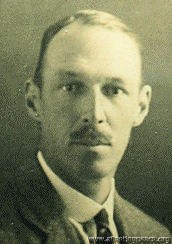 photo: 1927, aged 35
photo: 1927, aged 35 -
Chalmers, Edith May
Mrs Edith May Chalmers
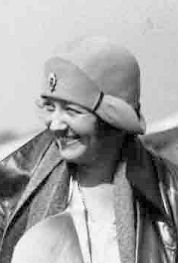
b 1894 in Flintshire, Wales
Edith May Burlingham as was; married JWP Chalmers in 1915, then Frank Forrest in Dec 1937.
Chairperson of Directors of the Forum Club, who organised endless luncheons and dinners for famous aviators of the time.
d. Dec 1985 in Devon
-
Chalmers, John William Pender
Mr John William Pender Chalmers
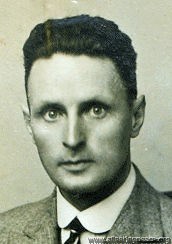
photo: 1928, aged 40
born in Morro Velho, Brazil -
Chamberlayne, Paul Richard Tankerville James Michael Isidore Camille
Capt Paul Richard Tankerville James Michael Isidore Camille Chamberlayne AFC
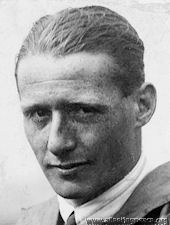
known as 'Tanks' (rather than Paul Richard Tankerville James Michael Isidore Camille).
b 15 May 1895 in Larnaca, Cyprus, of an Austrian family; educated at Eton, then a Captain in the 11th Hussars in WWI who transferred to the RFC in 1915. He then went to Canada in 1918, and was Chief Flying Instructor at the Toronto 'School of 'Special Flying' for a year.
Whilst racing at Hendon in July 1919, a couple of weeks after the Aerial Derby, Capt Chamberlayne had a "miraculous escape... [he] is to be congratulated on still being alive. He lost control of the machine and flew straight into one of the iron supports of a hangar. Fortunately the machine remained 'stuck' where it had hit, and he managed to extricate himself almost unhurt, although soaked with petrol."
He had already won the race, btw, and was just showing off.
Later, Chief Pilot of the Grahame-White School of Flying, then rejoined the RAF (India in 1920, Andover in 1927, Sqn-Ldr in Iraq 1932-35, Assistant Air Attache in Paris 1937 then Lisbon in 1938).
Wing Commander from 1938; Air Commodore in 1943.
When war was declared in Europe in 1939, he became desperate to return to Britain to see action and apparently "tried to upset the German Embassy by getting drunk and singing 'Rule Britannia' under their windows."
d. 3 May 1972
-
Chand, Dewan Misri
Lt Dewan Misri Chand
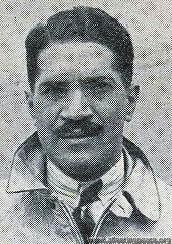 in 1936
in 1936b. 11 October 1907
'Infantry Officer in the Indian Army who learned to fly with the Bombay Flying Club and has followed the sport with zest. He won the Viceroy's Cup Race in February, flying a hired Club Gipsy Moth, and came to England to have a shot at higher game.'
Also entered for the Schlesinger (Portsmouth - Johanesburg) Race in 1936, but the aircraft was not ready in time.
Later, a Major General.
d. 13 March 1970.
On 22 October 2009, the Indian Post Office issued a stamp in his honour.
-
Chappell, Roy Williamson
Roy Williamson Chappell
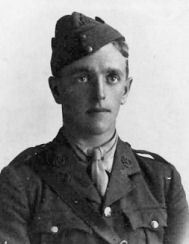 in 1916, as a 2nd Lieut., R.F.C.
in 1916, as a 2nd Lieut., R.F.C.b. 31 Dec 1896 in Croydon
RFC in WWI; Mentioned in Despatches in 1917, wounded in January 1918, then the Military Cross in June; "Temp. Capt. ROY WILLIAMSON CHAPPELL, R.F.C.—For conspicuous gallantry and devotion to duty. He showed the greatest skill and courage in leading patrols, with the result that during four days' operations the formations which he led destroyed nineteen enemy aeroplanes and drove down several others, the fate of which was not observed, owing to the intensity of the fighting. He has destroyed altogether five enemy machines, and has driven down seven others out of control."
Having ended WWI with 18, er, 'Huns', he took part in the RAF Pageant of 1920 "the Kenley team (consisting of Flight-Lieut. T. E. Salt, A.F.C. (3 Huns), Avro ; Flying Officer F.L.Luxmore (4 Huns), Bristol; and Flight-Lieut. R. W. Chappell, M.C. (18 Huns), Snipe) proved an easy winner."
-
Clayton, Roscoe TM
Mr Roscoe TM Clayton
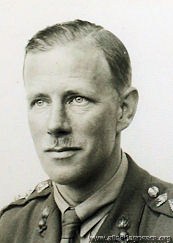 in 1931, when a Captain in the RE, at RAE Farnborough, aged 31
in 1931, when a Captain in the RE, at RAE Farnborough, aged 31Not sure about this - he's the only R Clayton I could find
-
Cleaver, Adelaide Franklin
Adelaide Franklin Cleaver
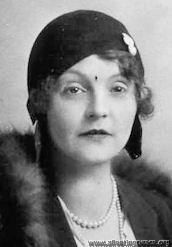
b. Adelaide Pollock in Northern Ireland in c.1885, the daughter of the Minister of Finance.
Adelaide (a.k.a. Mrs Hylton Spenser Cleaver) spent 3 months in 1929 flying to India and back, in her DH60G Gispy Moth G-AAEA. She was piloted by Captain Donald Drew, of Imperial Airways, and arrived back at Croydon on June 10th.
Here they are, lunching in the desert:
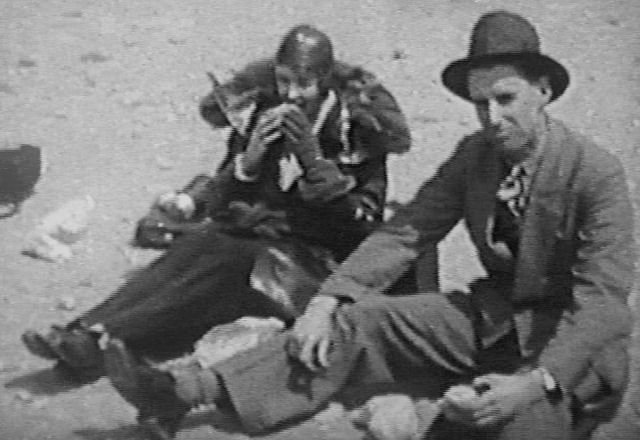
They had travelled as far as Egypt with Leonard Slatter, who was flying his newly-delivered Bluebird to Cape Town.
She didn't get her RAeC Certificate until June 1930, so I suspect he did most of the flying on that trip. However in Ocotber 1930 she made probably her greatest achievement - her flight from New York to Hollywood in her Moth, which she took with her on a steamship.
In July 1933, she was responsible for a "well-organised Flying Display which was held at Aldergrove Aerodrome, Co. Antrim. Her avowed intention was to stimulate air-mindedness in Ulster, and from the number of spectators who went to see the Display there is little doubt that she succeeded. We gather that from every point of view it was a great success."
In 1934, Mary de Bunsen wrote that "Mrs Spencer Cleaver makes the usually fatiguing journey to Northern Ireland three or four times a year in her own aeroplane, and, fitted with extra tanks to save refuelling during the day, it has many times enabled her to breakfast in London, shop in Paris from 11 to 1, and return in plenty of time for dinner at her house in London."
She owned:
a 1929 DH.60G Gipsy Moth, G-AAEA, which she sold to Venetia Montagu;
a 1930 DH.60G Gipsy Moth G-AAVY, which she sold to Lady Howard de Walden;
a 1930 DH.80A Puss Moth, G-ABFV, and
a 1933 Percival D.2 Gull Four IID, G-ACIP.
d. 14 August 1939 at Cooden, Sussex 'after a long illness', aged 54.
-
Cliff, Leslie Harold Talbot
Mr Leslie Harold Talbot Cliff
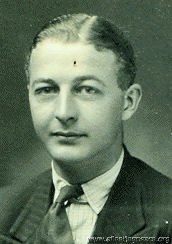 in 1930, aged 22
in 1930, aged 22b. 5 Jun 1908 in The Curragh, Ireland.
In 1930, a Law Student', address given as the Langham Hotel, London.
m. 1935 Violet H [Supple]
By 1936, 'A flying instructor at Brooklands, and a skater of some repute' - he and Violet "skated pairs, winning bronze medals at the World Championships in 1936-37, a silver medal at the 1936 European Championships, and they came fourth in the 1938 Worlds and 1933 and 1937 Europeans.
They won the British Championship every year from 1934-38. When they sought to regain their title after the war, in May 1946, they were beaten by Dennis and Winnie Silverthorne."
see https://www.sports-reference.com/olympics/athletes/cl/leslie-cliff-2.html
1936
see http://skateguard1.blogspot.com/2019/03/the-1936-world-figure-skating.html
d. 2 Aug 1969 - "Brunthorpe", Mont Gras d'Eau, St. Brelade, Jersey
His obituary in 'Flight' says "Leslie Cliff, AFC, who died recently at his home at St Brelades Bay, Jersey, was one of those who played their part in popularising British private flying in the early thirties.
In 1928 he owned a D.H. Puss Moth and learned to fly in it at Lympne, and in 1935 he became one of the instructors of the Cinque Ports Flying Club at Lympne; he moved from there to Brooklands in 1937.
In the following year he entered the King's Cup Air Race in a Miles Hawk and flew with his wife Violet into third place. The summer of 1939 found Leslie Cliff at Sywell, instructing at the RAF EFTS there.
Later he volunteered as a night fighter pilot on Beaufighters. When it was discovered that he had been a civil instructor with twin experience he was retained as an instructor, training pilots for night fighting. Towards the end of the war he was sent to Robertsfield, Liberia, for anti-submarine duties."
-
Cliff, Stephen Bertram
Mr Stephen Bertram Cliff 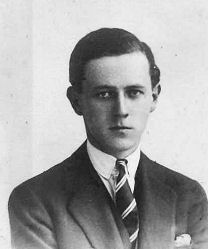 1929, Royal Naval College, Greenwich
1929, Royal Naval College, Greenwichb. 26 Oct 1907, Greetwell, Lincoln
Joined the Royal Navy 15 June 1925, Midshipman 1926, Acting Sub-Lieut from 1 Jan 1929
25 Jan 1929 - "Wants Fleet Air Arm!"
Resigned from RN 1 Sep 1929 and applied to the RAF the following year.
Post-WWII, a pilot for British South American Airways
-
Clouston, Arthur Edmond
F/O Arthur Edmond Clouston
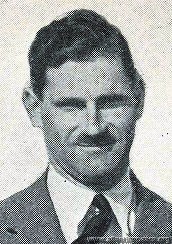 in 1936, aged 28
in 1936, aged 28Famous D.H. Comet pilot, from New Zealand. Civil Test pilot at RAE Farnborough in 1936. Flew Desoutters in other races.
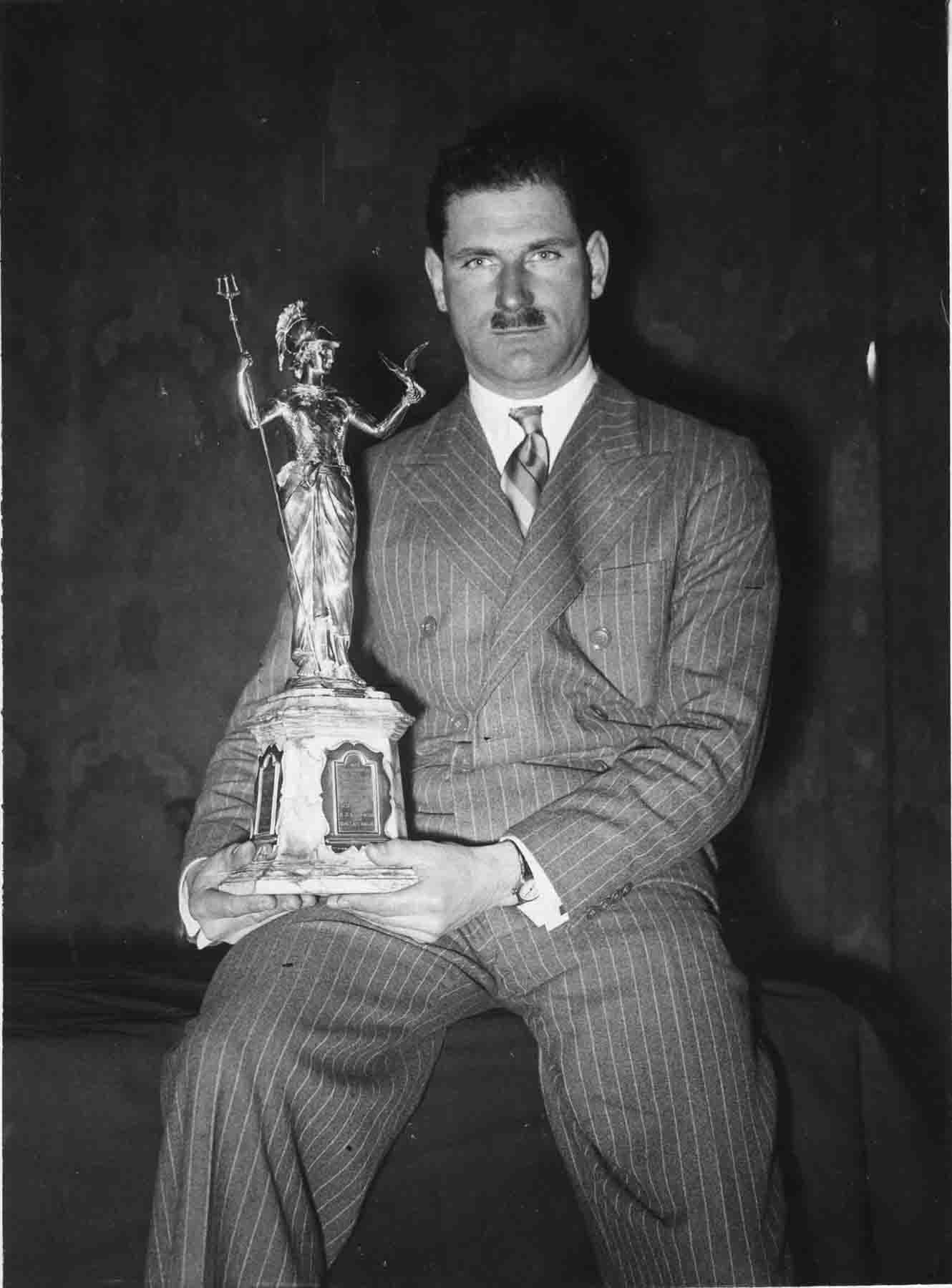 With the Brittania Trophy
With the Brittania Trophy© The Royal Aero Club [0654-0280]
d. 1984
-
Cobham, Alan John
Mr (Sir) Alan John Cobham KBE AFC
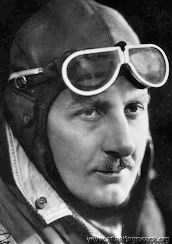 in c.1934, aged c.40
in c.1934, aged c.40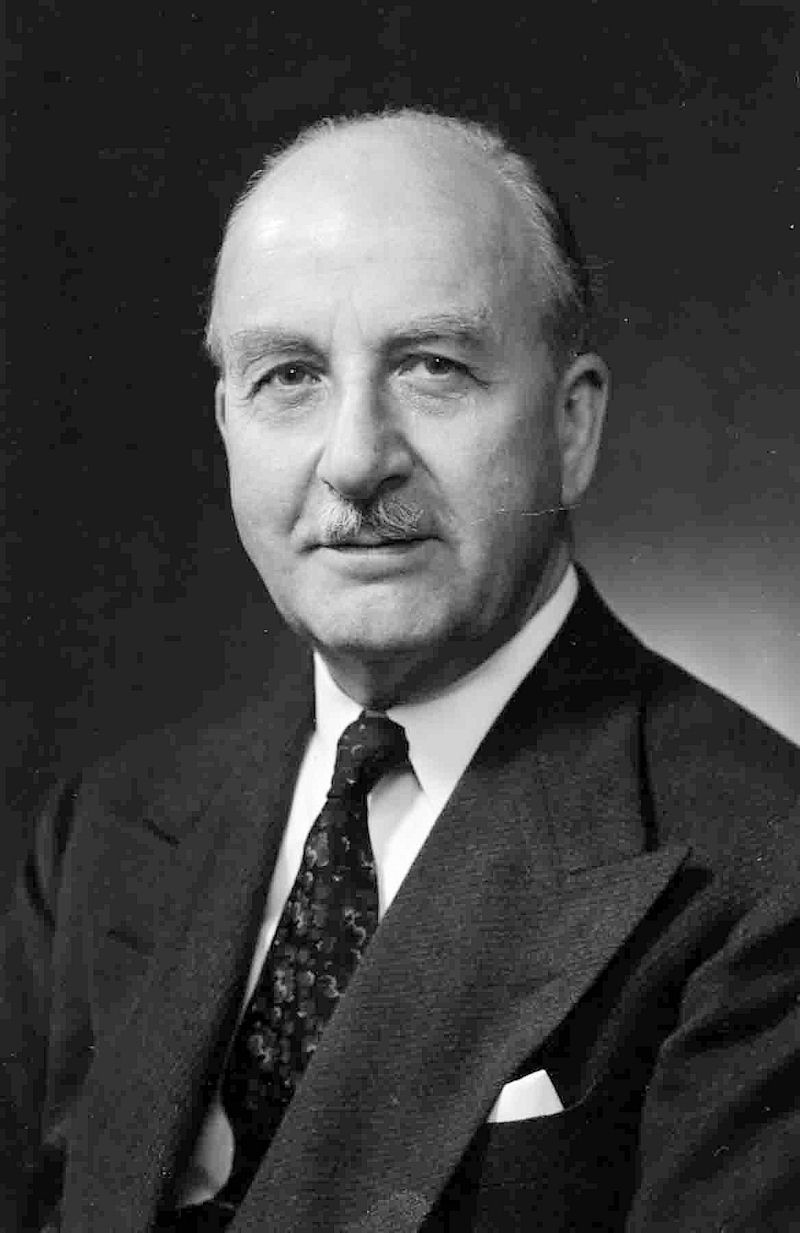
Page 4 of 23

